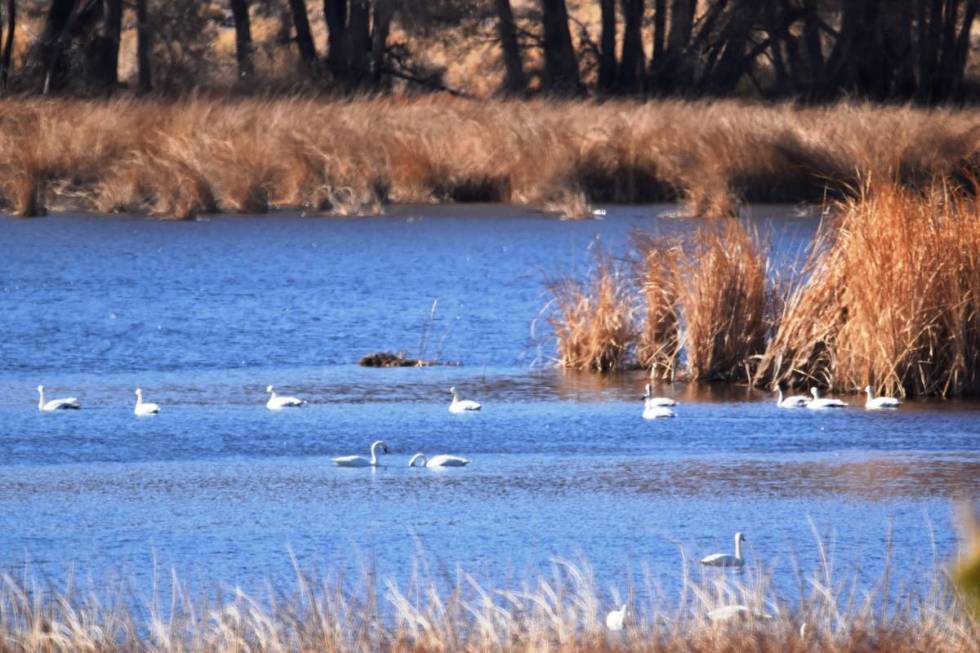Refuge offers glimpses of tundra swans, bald eagles

Winter at Pahranagat Lake reveals intricate reflections on placid waters and offers a lucky chance to spend time with dozens of tundra swans in the desert.
Temperatures at Pahranagat National Wildlife Refuge tend to run 10 degrees lower at night than in Las Vegas, enough of a difference to freeze shallow portions of the upper lake, where 130 swans are busy swimming and resting before their spring return to the Arctic tundra. Located about 1½ hours to the north, the refuge is an ideal spot to enjoy a winter’s day outside, especially when winds are light and the sun is bright.
Tall cottonwoods along the shoreline have dropped their leaves, allowing for good looks at occasionally perching bald eagles and ospreys fishing for lunch. An easy 3-mile trail circles the lake and lets hikers get acquainted with the wetlands habitat and possibly see pintail ducks and Canada geese, which were recently spotted strutting across lake ice.
Visitors who don’t want to hike 3 miles may choose to walk along just part of the Upper Lake Trail and across the lake’s dike, which offers the best vantage point for remarkable reflections of surrounding mountains and shorelines. On a short walk, day-trippers can still appreciate broad views of what in the Paiute language means “valley of shining water.” Pahranagat’s protected 5,382 acres are a Mojave desert oasis that’s a year-round home to abundant wildlife and an important food-and-lodging stop for migrating birds as they navigate the Pacific Flyway.
In late December, I made time for Pahranagat. A chance to glimpse the grace of tundra swans has become a tradition.
Shortly after we exited Interstate 15 to drive north on two-lane U.S. Highway 93, rugged mountains rose into view. The geology show continued to play until the Upper Pahranagat Lake turnoff, which is just past the lake itself. Its entrance road is on the left shortly after a separate turnoff for the refuge’s visitor center, which is currently closed because of the COVID-19 pandemic.
As we approached the upper lake turnoff, dozens of white dots came into view across the waters weaving through patches of golden reeds in the north marsh of Upper Pahranagat Lake. Swan luck was on our side.
“They’re a very charismatic species,” refuge manager Rob Vinson said. “A lot of people enjoy coming out to see them. Many are pleasantly surprised to see the swans.”
Visiting from Arctic summer breeding grounds most likely in Alaska, the Pahranagat tundra swans typically show up in November or December and fly away in mid-February, Vinson said.
With just a few weeks remaining for potential swan sightings, Vinson recommended avoiding even days at Pahranagat because the swans will typically be at their preferred aquatic plant feeding grounds at Frenchy and Nesbitt lakes farther north. Those same swans will avoid those lakes on odd days because that’s when hunting takes place in the Key Pittman Wildlife Management Area.
“So if people want to come see the swans and want to hike at Pahranagat, they should come on odd days,” he said.
From a distance on a December day, I listened to the swans honking, bugling, whistling and clucking, which at times sounded coordinated and refined. With binoculars, I watched graceful pairs glide through Pahranagat waters and wondered if they were mates for life, as is believed to be the case for swans. I saw single swans keeping vigilant watch over small sleeping groups. A few swans landed and took off or stretched their wings while remaining in the water. Vinson called some of their behavior “loafing.”
The more time spent watching the swans, the harder it becomes to resist anthropomorphizing. It’s easy to assume that bossy swans are trying to cajole stragglers to speed up or that swan parents are fretting over their gray cygnets’ blossoming independence. Pahranagat’s juvenile swans, whose feathers will change to white this summer if they make it back to the Arctic tundra, migrated thousands of miles to Nevada, even though they were only a few months old when their journeys began last fall.
Swans fly in family units, and some of those same gray cygnets could return as adults next winter to Pahranagat after having learned the migration route this season. It’s a complicated path with several unfrozen water stops, including a likely one at the Great Salt Lake. The swans aren’t banded, so there’s limited knowledge, but they could break off from a much larger group that continues west to winter in California after a brief stop in Northern Nevada. “I want to assume there’s some repeat customers coming down here,” Vinson said.
With their 6- to 7-foot wingspans, tundra swans are able to fly in and out as they please, so there have been winters when I’ve missed them at Pahranagat. But I’ll keep trying every year for the chance to eavesdrop on their musical conversations and watch their swan dramas unfold in the “valley of shining water.”